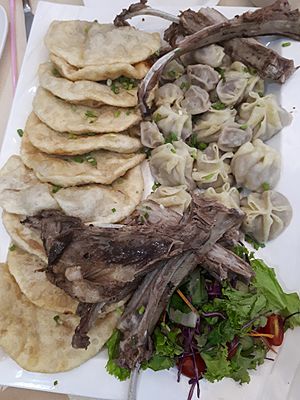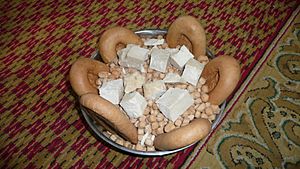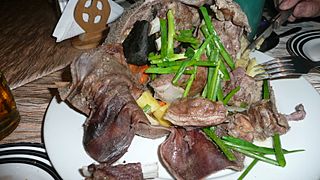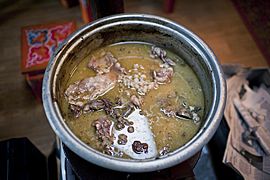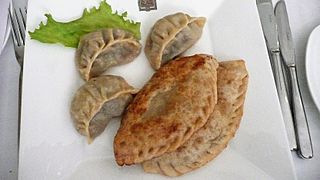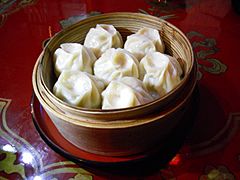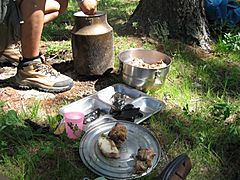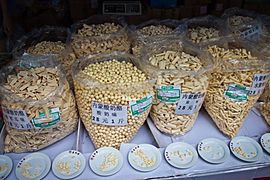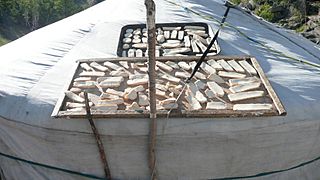Mongolian cuisine facts for kids
Mongolian cuisine is mostly about dairy products, meat, and animal fats. This is because Mongolia has a very cold and dry climate. The most common food in the countryside is cooked mutton (sheep meat). In cities, steamed dumplings filled with meat, called "buuz", are very popular.
Mongolia's extreme continental climate has shaped its traditional diet. People use few vegetables and spices. Also, because Mongolia is close to China and Russia and has strong historical ties with them, its food is influenced by Chinese and Russian cuisine.
Contents
History of Mongolian Food
We know about the old food of the Mongol court from a book called Yinshan Zhengyao. This cookbook was written by Hu Sihui in 1330. It was presented to Tugh Temür, a Mongol emperor. The book shows how food ideas traveled between different cultures, especially from the Middle East to the Mongol Empire.
Food at the Mongol Court
People who saw the feasts at Kublai Khan's court described them. They served fermented mare's milk called kumiss with onions. They also ate horse meat, roast mutton, venison (deer meat), quail, pheasant, chicken, and even bear meat. Red wine and a rice porridge called congee were also served.
According to Marco Polo, the Mongols hunted daily in winter. They sent lions, stags, bears, and wild boars to the Khan's court. The Khan even had trained leopards, eagles, and wolves for hunting.
What Influenced Mongolian Food?
Nomadic Lifestyle
Early Mongolian food was likely similar to other nomadic groups on the steppes. Mongols mainly ate milk and meat from their herds. They also hunted and gathered plants, especially when food was scarce in winter.
Sheep were very important. They provided milk for dairy products and meat. Horses gave milk for kumys, a special fermented drink. Their meat was also valued for being hearty and nutritious. Other animals like reindeer and sarlag (a type of yak) were also part of their diet.
Mongols hunted wild animals like the marmot. Grains were often hard to find and usually traded or taken from other groups. We don't know how important vegetables, fungi, and fruits were. However, stories suggest that people ate wild plants only when they had to. For example, Genghis Khan's mother, Hoelun, had to feed her children from wild plants after her husband died.
Some wild plants eaten by Mongols included:
- Scarlet lily bulbs
- Garden burnet root
- Wild apple
- Bird cherries
- Chinese chives
- Wild garlic
- Wild onions
- Cinquefoil root
Chinese Influence
The Yinshan Zhengyao cookbook shows recipes influenced by Central Asia, mostly in northern China. Even today, dishes with lamb, special breads, and fried dumplings are more common in northern Chinese food. In southern China, fish, rice, pork, and vegetables are more popular.
Muslim Influence
Some recipes in the Yinshan Zhengyao are like those from old Arabic cookbooks. This suggests that food ideas might have spread from the Middle East to Mongolia. For example, Lactic acid fermentation was used to preserve dairy products like dried yogurt. This was called kashk in Iran and qimaq in the Yinshan Zhengyao.
Key Features of Mongolian Food
Nomads in Mongolia get their food directly from animals. These include cattle, horses, camels, yaks, sheep, and goats. They also eat wild game.
Meat is cooked, used in soups and dumplings like buuz, khuushuur, bansh, and manti. Meat is also dried for winter, called borts. The Mongolian diet has a lot of animal fat. This is important for Mongols to stay warm in cold winters, which can reach −40 °C (−40 °F). It also gives them energy for hard work.
Milk and cream are used to make many drinks, cheeses, and similar products. In the countryside, nomads usually provide for themselves. Travelers can find guanz (simple restaurants) in gers along the road. A ger is a portable home. In a ger, Mongolians cook in a pot on a small stove. They use wood or dried animal dung (argal) as fuel.
Popular Mongolian Foods
The most common dish in the countryside is cooked mutton, often plain. Sometimes, vegetables and flour are added as side dishes. In cities, you'll see many signs for "buuz". These are steamed dumplings filled with meat. Other types of dumplings are boiled (bansh, manti) or deep-fried in mutton fat (khuushuur).
Other dishes mix meat with rice or fresh noodles. These can be stews like tsuivan or budaatai khuurga, or noodle soups like guriltai shöl. Sülen is a type of hot pot dish.
A special cooking method is used for special events. Meat, often with vegetables, is cooked using stones heated in a fire. This can be done with mutton chunks in a sealed milk can (khorkhog). Or, it can be done inside the belly of a goat or marmot that has had its bones removed (boodog).
Milk is boiled to separate the cream (öröm, clotted cream). The leftover skimmed milk is made into cheese (byaslag), dried curds (aaruul), yogurt, kefir, and a light milk liquor (shimiin arkhi). The most famous national drink is airag, which is fermented mare's milk.
A popular grain is barley. It is fried and malted. The flour from this (arvain guril) is eaten as a porridge with milk fat and sugar. It can also be mixed into milky tea. The everyday drink is salted milk tea (süütei tsai). This tea can become a hearty soup by adding rice, meat, or bansh.
Vodka has also become popular, with many local brands. Boortsog is a type of fried dough. It is shaped into triangles or spheres. The dough is made from flour, yeast, milk, eggs, and other ingredients.
Horse meat is eaten in Mongolia and can be found in most grocery stores. Mongolian sweets include boortsog, which is a type of biscuit or cookie eaten on special occasions. Vodka is the most popular alcoholic drink. Chinggis vodka, named after Genghis Khan, is the most popular brand.
Custom of Hospitality
Mongolian people have strong rules about hospitality and helping others. It was traditional to offer a warm welcome even to strangers or sometimes even enemies.
See also
 In Spanish: Gastronomía de Mongolia para niños
In Spanish: Gastronomía de Mongolia para niños


